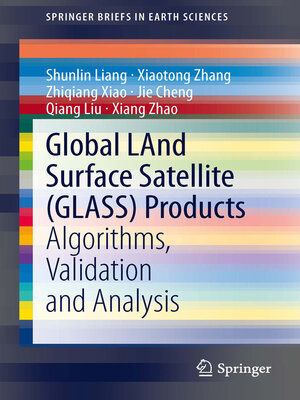Global LAnd Surface Satellite (GLASS) Products
ebook ∣ Algorithms, Validation and Analysis · SpringerBriefs in Earth Sciences
By Shunlin Liang

Sign up to save your library
With an OverDrive account, you can save your favorite libraries for at-a-glance information about availability. Find out more about OverDrive accounts.
Find this title in Libby, the library reading app by OverDrive.



Search for a digital library with this title
Title found at these libraries:
| Library Name | Distance |
|---|---|
| Loading... |
This book describes the algorithms, validation and preliminary analysis of the Global LAnd Surface Satellite (GLASS) products, a long-term, high-quality dataset that is now freely available worldwide to government organizations and agencies, scientific research institutions, students and members of the general public.
The GLASS products include leaf area index, broadband albedo, broadband emissivity, downward shortwave radiation and photosynthetically active radiation. The first three GLASS products cover 1981 to 2012 with 1km and 5km spatial resolutions and 8-day temporal resolution, and the last two GLASS products span 2008 to 2010 with 3-hour temporal resolution and 5km spatial resolution. These GLASS products are unique. The first three are spatially continuous and cover the longest period of time among all current similar satellite products. The other two products are the highest spatial-resolution global radiation products from satellite observations that are currently available.
These products can be downloaded from Beijing Normal University at http://glass-product.bnu.edu.cn/ and the University of Maryland Global Land Cover Facility at http://www.glcf.umd.edu/
The GLASS products are the outcome of a key research project entitled "Generation & Applications of Global Products of Essential Land Variables", supported by funding from the High-Tech Research and Development Program of China and involving dozens of institutions and nearly one hundred scientists and researchers.
Following an introduction, the book contains five chapters corresponding to these five GLASS products: background, algorithm, quality control and validation, preliminary analysis and applications. It discusses the long-term environmental changes detected from the GLASS products and other data sources at both global and local scales and also provides detailed analysis of regional hotspots where environmental changes are mainly associated with climatechange, drought, land-atmosphere interactions, and human activities.The book is based primarily on a set of published journal papers about these five GLASS products and includes updated information. Since these products have now begun to be widely used, this book is an essential reference document. It is also a very helpful resource to anyone interested in satellite remote sensing and its applications.







